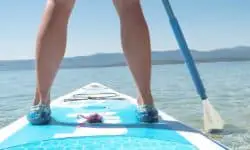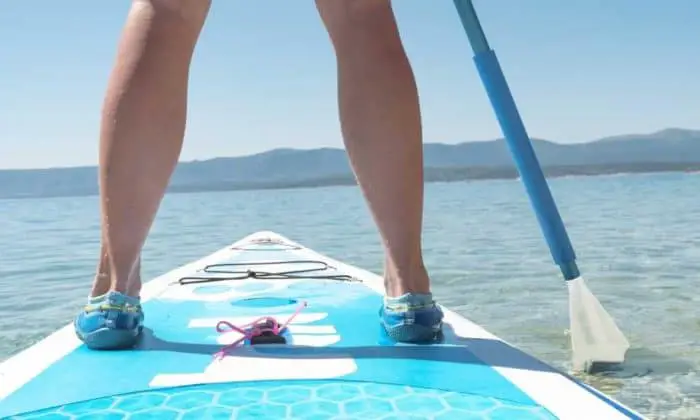As an Amazon Associate we earn from qualifying purchases.

Beginners in any water sport have to be extra cautious so that they can enjoy the sport, safely. Water sports are really thrilling but if you are not skilled enough, they can be risky too. The same holds true for standup paddleboarding. A beginner should not try to cover large bodies of a water that an ace paddler can easily do.
If you are at the beginner’s stage of standup paddleboarding, you should opt for buying or renting a standup paddle board for beginners. However, how can you select the best board for beginners? Use this checklist to help choose your board:
Table of Contents
Yes, a leash for your Standup Paddleboard
A leash is important for all paddlers, but if you are a beginner in this sport it is a must-have component for you (https://standupjournal.com/tips/why-you-need-a-sup-leash-this-will-save-your-life/). Different types of leashes are available for most boards. Calf leashes and ankle leashes are the two most common types of paddle board leashes.
From a safety aspect, there are two vital reasons behind the use of a leash. These are:
- It ensures a flotation device is near in case you fall off your board. The board is a life-saving flotation mechanism, and you don’t want it sliding away in any kind of emergency.
- It is safer for other users around you because sometimes beginners may lose control of their paddle boards.
If you are a beginner to SUPing, a straight leash, approximately 2′ longer than your board will be a better option for you than a coiled one.
Check the paddle carefully
The paddle works as the main propeller for you and your board, therefore you need to check its fit and function before you go paddling off into the sunset. Check these few aspects before choosing one:
- The paddle should reach up approximately as high as your raised arm, while standing on flat ground. Inflatable boards are thicker, which will affect the length of your paddle.
- You should be comfortable in using the paddle vertically so that you can stroke with power. Check the grip, and placement of the joint or cam lock. Is everything comfortable for you?
- The paddle blade should show no cracks, and if it’s a collapsible paddle, make sure the mainstay button is working so you don’t lose part of your paddle while away from shore.
Check the structure of the paddle board
The ideal structure of a paddle board is a narrow nose for cutting through water and a stable body and square tail. This is a perfect setup for beginners. While you are selecting a standup paddle board, you should keep your eye out for overly rounded boards, that are less than 5″ thick (avoid those), and make sure to get a good hydrodynamic shaped board. A large EVA foot deck comes standard on most inflatable standup paddle boards, as well as traditional paddleboards.
Choosing the correct fin can be equally as important. Make sure that the fins are positioned at the rear of the board (if the rail allows for shifting forward or aft) before renting or buying a standup paddle board for beginners. An aft-positioned fin will provide you with better stability while propelling you forward and will help you move straight in both wind and heavy paddling.
Stiffer fins, but with a rubber rim, are an excellent choice for surfing in waves safely. These are also great for beginners. Many inflatable boards come with two smaller river fins, which are fixed in place on the board, and one removable center fin. The main, or center, fin is usually at least 8″ tall.
Go for a board that is wide
Paddle board width hardly matters for seasoned paddlers, but for the beginners it is a huge factor. If you are new to this water sport, it is safer for you to arrange a standup paddle board that is broad in width. The wide structure will offer better stability and will help you enjoy better balance on the water surface. The largest width commonly found is 36 inches, and we recommend looking for a board near that dimension. The Peak 10’6″ iSUP by Isle Surf and Sport is a great board to check out.
A beginner often faces challenges in maintaining their stability on the water surface. You, as a beginner, will surely face the same issue. Therefore, the wider the board you select, the better the level of comfort in mainlining your balance.
Consider the length as well
Length of the paddle board matters for the beginners. The length of the board should be chosen according to your body weight and the nature of your paddling. Before you buy a large one, think about some factors:
- Carrying it to the water especially on a windy day can be difficult.
- Storing a large board can be an issue.
Therefore, before buying or renting a large paddle board, you should consider the nature of paddling that you have planned.
- If you want to enjoy paddleboarding as a beginner, a 10’-12‘ long board will be sufficient.
- If you have a plan for racing or covering long distances, paddle boards with 12’.6” or 14′ length will be ideal.
Before you select a paddle board for beginners, it is important to check the length according to your body weight. You should consult an expert paddler if you wish to be sure about this.
Inflatable paddle boards are better option for beginners
Beginners in paddleboarding should consider choosing an inflatable paddle board over other options. These are extremely durable, inexpensive and easy to store and carry to the water. These inflatable boards are available in a wide variety of materials. PVC boards are the best option for beginners.
In case you want to try a non-inflatable board, try a fiber glass board. Fiber glass paddle boards are a better option because they are stronger and stiffer than other plastic boards. They will offer you better stability while enjoying SUP surfing, or paddling longer distances on flat water.
General tips on safe and successful paddling for beginners
Finding the best paddle board for beginners can be a challenge but this should not stop you from enjoying smooth sailing and standup paddleboarding. Apart from selecting a suitable board, you need to follow a few general guidelines as well:
- Relaxed paddling and looking at the horizon are the best ways to maintain balance of your board and body on the water surface.
- For best stability, you should place your body at the middle of the board and keep your feet wide.
- Keep your knees slightly bent and shoulders relaxed and centered.
- Use your core muscles to restrict the swing of the board each time you paddle.
- Try to paddle gently and consistently. It is wise for beginners to start standup paddling on a calm flat water surface.
These are a few tips on finding the best standup paddle board for the beginners. If you choose a paddle board correctly, you will have more fun on the water, and do it safely!
Make sure to share and comment below! Have a board that you tried and love!? Let us know! Thanks for reading.
Amazon and the Amazon logo are trademarks of Amazon.com, Inc, or its affiliates.

